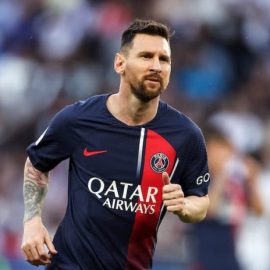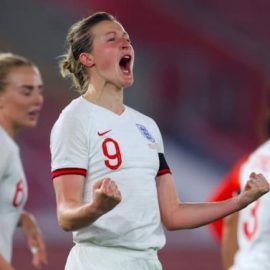According to a Russian proverb, the future belongs to those who know how to wait. And for some of those far beyond the long afternoon shadows of the Luzhniki, the waiting is over.
Late last year, gold was wrenched eastwards to Tatarstan, from whence the Golden Horde once poured west. Rubin Kazan, crowned champions of Russia in November 2008 – on their fiftieth anniversary – spent 45 years outside the top division until 2003. It took their immediate predecessors at the top, Zenit St. Petersburg, 14 more years than that to win their first league title in 1984, and then another 23 to repeat the feat in 2007.
As a result, two years have now passed without a Moscow side taking the league. With nearly a third of the 2009 Russian season completed, Rubin again lurk menacingly, just one point off the top of the table. Considering that Zenit’s triumph broke a sequence of title wins by Moscow-based sides stretching back twelve years, perhaps at last it makes sense to talk of a regional shift in the dynamics of Russian football.
Moscow has yet to fall – CSKA, rejuvenated under Zico, remain this year’s early pace-setters. Dynamo finished third last time, and Miodrag Božović looks set to work similar wonders this year with FC Moscow as he managed with Amkar Perm in 2008. On the other hand, the traveling sideshows advertised as Spartak and Lokomotiv are still very much playing the carnival circuit, and whilst there may be life on Mars, there’s not much of it at FC Saturn. But far away, above all on the shores of Ladoga and deep in the land of the Tatars, change has long been in the making.
The interesting thing is that although Zenit and Rubin took different ways to the top, both started from a common basis. Even before the recent successes of their teams, St. Petersburg and Kazan were always two cities which cared about football. In a league where the team generally accepted as the most attractive, namely CSKA, struggle to pull crowds over 10,000 for regular league games, Rubin’s usual attendances of around 15,000 and Zenit’s constant sell-outs of the damp, permanently windswept 21,000 capacity-Petrovksy stand as the clearest expression of their strong local backing.
This is the base from which two successive ascents of the mountain began. With the active support and backing of the fans, who accepted the need for patience and a long-term vision if 1984 was not to be a glorious anomaly, Zenit assiduously nurtured a superb youth programme which produced Andrei Arshavin, Vyacheslav Malafeev and Igor Denisov amongst others. A sponsorship deal signed with Gazprom in late 2005 gave the club the financial clout to retain such players, who in earlier times would otherwise have gravitated towards the Moscow orbit, as well as supplement them with high-level reinforcements.
Similarly, Rubin took a regional enthusiasm for sporting activity and development, long championed by Tatarstan president Mintimir Shaimiev, and combined it with the remarkable ability of manager Gurban Berdiýew – also the club’s vice-president since 2004 – to squeeze performances from the creaking legs of stagers such as Serhiy Rebrov and, until his recent retirement, Savo Milošević.
So given the key role played by a genuinely pervasive football and sporting culture in two recent provincial success stories, could there be another Zenit or Rubin? Maybe, just maybe. Distant though the prospect may be, a future powerbase of Russian football may lie in the south of the country.
In fact, before Zenit’s 2007 victory, the last non-Moscow league champions were 1995’s Spartak-Alania Vladikavkaz, under the guidance of Valery Gazzaev, who a decade later would lead CSKA to the first treble in Russian history. Alania’s triumph encapsulated a short golden period in which they, or fellow southerners Rotor Volgograd, had consistently challenged the capital’s hegemony by finishing in the runners-up spot. Moreover, the win inaugurated an era in which players from Alania, Rotor or FC Rostelmash Rostov finished as the league’s top scorer for five years running.
However, time, just like the lazy currents of the infinite Volga, flowed on. Despite their achievements, both Alania and Rotor – who knocked a thoroughly complacent Manchester United out of the 1995 UEFA Cup – slowly succumbed to decline, relegation, expulsion and eventually reformation. But fast forward to May 2009. Although Rotor still languish in the shadows of the Russian Second Division, a revival of southern football finally seems at hand.
Alania, reinforced by some inspired winter transfer dealings and playing some excellent attacking football, are currently top of the Russian First Division and in line for a return to the highest league. Although the division’s other southern representatives, FC Krasnodar, Chernomorets Novorossiysk and Volgar-Gazprom Astrakhan are off to fairly dismal starts, Alania are currently accompanied in the automatic promotion spots by those doyens of endless dusty Caspian dreams, Anzhi Makhachkala.
Promotion for either Alania or Anzhi is still a long way off. The Russian First Division is the world’s toughest league competition, painfully obvious to its participants but almost completely unknown to anybody else. They suffer in silence.
But were either – or indeed both – to manage it, they would join a Premier League of which southern sides, namely Spartak Nalchik, Terek Grozny, Kuban Krasnodar and FC Rostov, already make up a quarter of the participants.
The latter two clubs, both relegated from the top division in 2007, showed great resilience in achieving instant promotion back up in 2008 and now appear to have the necessary experience and fortitude to survive, even if Kuban have resorted to borrowing almost half their team from Lokomotiv.
Nalchik, in their fourth straight season at the top, have faded significantly since a giddy period in the late spring of 2006 when they spent over a month as league leaders, but will, along with Terek, likely be redeemed by the almost cosmic ineptitude of the sides currently below them, Saturn and FC Khimki. The men from Vladikavkaz may once have been kings for a day, but their fellow southerners are slowly, ever so slowly, beginning once more to encircle the capital.
Southern Russia not only produces teams, but also players. No less than six members of Guus Hiddink’s most recent Russia squad, namely Alan Dzagoev, Vladimir Gabulov, Denis Kolodin, Renat Yanbayev, Ivan Saenko and Roman Pavlyuchenko, hail from the south, and plans are in place to ensure that this pipeline is both protected and strengthened. Regional and federal authorities, often with clear reference to the successful Tatarstan blueprint, are beginning to implement a range of sports investment initiatives, and the 2014 Sochi Winter Olympics – with a reported aggregate budget of around $12 billion – are expected to provide a major boost to the development of sporting infrastructure in the region.
But most importantly, when considering the Zenit-Rubin model, all these teams are well-supported, and serve as permanent focal points for strong local footballing passion. In particular, Krasnodar has long been something of a hotbed, exemplified by a dedicated away following – still a relative rarity in Russia – and by a mass rally outside their stadium in late 2007 following ultimately exaggerated rumours of Kuban’s impending loss of professional status. Anzhi consistently attract the biggest crowds in the First Division, and their away match against Alania in the second round of this season saw 19,500 spectators at the Spartak Stadium – more than any Premier League game the following weekend.
Of course, none of these teams are in a position to seriously challenge for the Premier League title any time soon. Moreover, both Zenit and Rubin have shown that a footballing culture, indispensable though it is, cannot in itself function as a magic bullet for success, and there remain a number of issues for the south to confront before the region’s potential can begin to be realized.
Firstly, southern sides need to find a way to hang onto their talent. Of the six southerners in the national team referred to above none play in their native region, where teams face the universal conundrum of needing the players to achieve success whilst simultaneously needing the success to get the players.
Secondly, financial mismanagement is, unfortunately, as prevalent across the southern plains as anywhere else in Russia, a fact amply demonstrated by the recent voluntary relegation to the Second Division of SKA Rostov, the Soviet Cup winners in 1981. There is also the suspicion that the region, vast as it is, may nevertheless be spreading itself too thin when it comes to the number of teams. Both Zenit and Rubin – the efforts of Dynamo St. Petersburg and KAMAZ Naberezhnye Chelny aside – have notably large catchment areas, whereas clubs in the south face greater internal competition for both support and resources.
The obvious solution of mergers faces the perhaps insurmountable obstacle of a socially, culturally and religiously fragmented region – if the idea of combining two teams from Krasnodar and Rostov seems improbable, the prospect of a Caucasian super-club based on the co-operation of, say, Terek, Anzhi and Alania – each, in very different ways, standard-bearers of regional or national particularism – appears completely absurb.
Yet maybe a way can be found. Maybe the south, by building wisely upon the strength of their support and regional roots in the same way as Zenit and Rubin, can one day emulate the latter’s success. Because as both these teams have shown, support – and patience – can eventually take the right organization and investment a long way.
It may take ten years, maybe fifty. But if it can be done, if the potential can be unleashed, then Moscow had better be prepared. The south will rise again.
Add Sportslens to your Google News Feed!






